Five Reasons You’re Missing Ducks

Kyle Wintersteen, Managing Editor
In considering the teal’s acrobatics, the pintail’s agility and the raw speed of canvasbacks and mallards, is it any wonder that ducks can bewilder even the savviest of wingshooters? To bag ducks consistently requires attention to detail, from shooting technique to selection of chokes and loads. Even so, everyone whiffs on the occasional mallard. But if you’re missing more than the odd duck, maybe it’s time to consider whether you’re committing any of these common mistakes.
Rushing the Shot
Do you frequently miss your first shot before getting on target with your second? That’s a key symptom of rushing the shot.
Ducks may be fast, but decoying birds provide ample time to smoothly mount the gun and shoot a couple. And hurried movements, contrary to their intent, don’t actually help you swing ahead of ducks — all that flailing causes your brain to perceive the birds as moving much faster than they are. In contrast, a slower, more deliberate gun mount makes the ducks themselves appear to fly more slowly, resulting in easier shots. Try it!
However, slowing your gun mount means one of your buddies is likely to shoot first. Perfect. While he’s under recoil, you can pick out backpedaling drakes hanging in the air for easy shots.
Aiming the Barrel
If you were to throw a football to a running receiver, you’d look at the receiver — not the tip of the football. And if you were to point your finger at a passing car, you’d look at the car — not your fingertip (or the motorist’s grimace). You aren’t actively aiming at the target in either endeavor, but rather relying on instinct and your brain’s subconscious calculations. That’s exactly how to shoot a shotgun.
Focus your eyes on the duck, with both eyes open, never glancing at your barrel or shotgun bead. Thus your brain is able to judge the duck’s distance and velocity, and guide your barrel to the correct lead. Consciously aiming a shotgun by focusing on the bead interrupts these instinctive calculations — you can’t focus on two objects at once — which increases the likelihood of a miss.
Using Large Shot
Despite the improvements to steel shotshells, it remains a good rule of thumb to select a load two shot sizes larger than lead for the intended purpose. So, given that the debate over the ideal shotshell for ducks used to center on No. 6 versus No. 4 lead shot, shouldn’t the steel debate pit a load of No. 4’s against No. 2’s?
Yet some duck hunters swear by BB or even BBB shot, despite the fact larger steel shot affords lower pattern densities, i.e. fewer pellets downrange, and can prove finicky on the pattern board. If you insist on large shot, consider whether you’re choking it too tightly. Steel lacks the malleability of lead, so patterns can be detrimentally affected as large steel pellets are crammed into a choke tube’s forcing cone — not to mention the stress imparted on the choke.
For geese and big, tough ducks such as eiders and scoters, the downrange energy afforded by larger shot can outweigh its drawbacks. For most ducks, however, a payload of Nos. 2 or 4 steel may improve your luck.
Neglecting to Pattern
Just as you’d never go deer hunting without sighting in your rifle, hunting ducks without visiting a patterning board is a roll of the ballistic dice. Is your shotgun’s point of impact consistent with point of aim? And is your pattern sufficiently dense for clean kills, which typically require 3-5 pellet strikes?
Your goal is 70 percent pattern density (70 percent of your shotshell’s pellets within a 30-inch circle) at the distance you expect to gun waterfowl. While advanced pattern adjustments are a topic for another day, aftermarket chokes can help, as can experimenting with a variety of shotshells. Knowing you’ve achieved a proper pattern is also good peace of mind, and nothing fosters good wingshooting like confidence.
Sloppily Mounting the Gun
You can pull your head off the stock, stop your swing, close an eye or commit any litany of wingshooting sins and still drop quite a few ducks. However, there’s one error in technique that almost guarantees the safety of any greenhead in your vicinity: a sloppy gun mount. Among other detrimental effects, a poorly mounted gun transfers stouter recoil and fails to align the rib with your dominant eye — at that point it doesn’t much matter if your gun’s throwing a good pattern.
Fortunately the summer months are an ideal time to perfect your gun mount, which doesn’t even require visiting a range. After ensuring your shotgun is unloaded, insert a Maglite flashlight into the muzzle — the AA model pairs nicely with a modified choke 12-gauge. Twist the flashlight’s beam until it’s as tight as possible. Now, with your shotgun in the ready position, direct the beam toward a corner of your ceiling. Smoothly mount the gun to your cheek without allowing the beam to waiver from the corner. A steady beam indicates a smooth gun mount. As you improve, trace the beam along the wall/ceiling seam as you mount and continue swinging the gun. A dozen daily repetitions of this drill can provide great results.

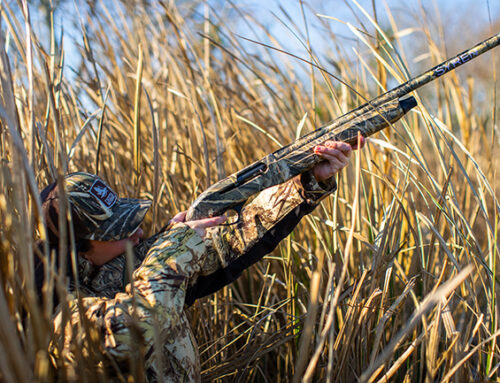
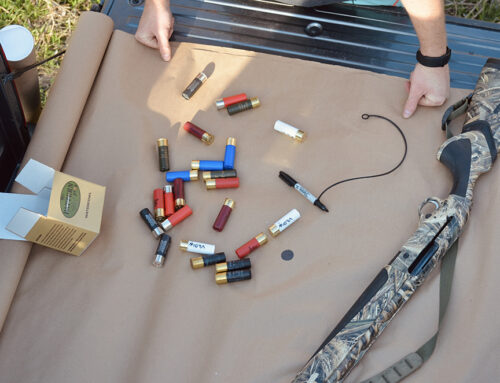
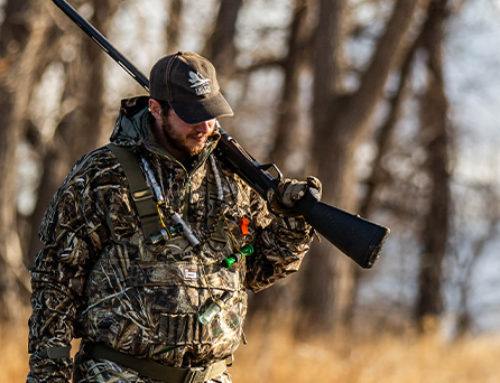
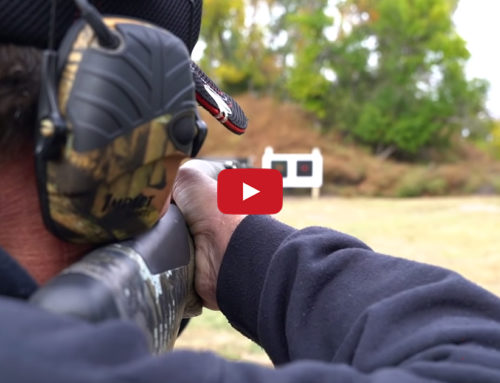
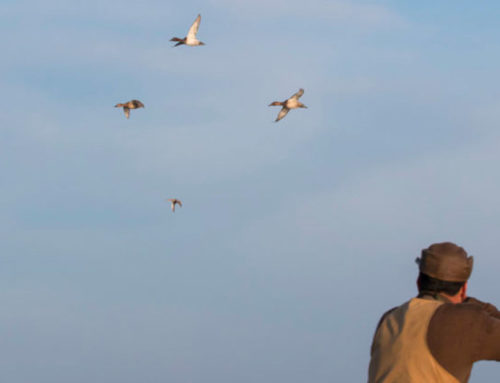
I like the comments. I can miss with the best of them so I can relate to the hunters who miss sometimes. That’s what makes hunting such a great sport. You have to put your time in to get better. The slow gun mount idea is very sound. Don’t get too excited or disappointed for an occasional miss. Sporting clays is a good opportunity to improve your fundamentals. It is a good opportunity to concentrate on the ducks instead of looking at the gun. Most hunters I know do not practice enough. They can shoot a box of shells and still not have a limit Yet, I don,t see many of them out trying to correct their mistakes. It usually takes several trips to the sporting clays course to consistently improve your skills.
Anyone shoots my ducks I’ll will hunt you down and………!!!
A lot in this article is outdated and completely ignores the vital importance of shot string. Because of the phenomena of shot string, the importance of a dense pattern and smaller shot is apparent when you can see this all in 3 D real time. Pattern is highly overrated, because of the fire hose effect of shot string, but yet we still see this talked about constantly almost in every article concerning shot gunning for waterfowl. The best articles I have seen on this is at http://www.duckhuntingalaska.com If you are “aiming” at waterfowl, you are not doing it right. The best shots are instinctive shooters on waterfowl. Waterfowl shooing is much different and complex than upland wing shooting as the birds are not just going away or crossing, but coming from every angle including behind you. A shooter must learn to deal with this, not to mention they will be often sitting in a boat or blind.
Good article. Another point of interest is gun fit. Purchased shotguns are sized for big, & tail and stocks can be shortened for proper fit. If its cold and you have a heavy coat on and you and/or your sibling is not 6′ 4″ and the shotguns being used have not been fitted the stock is probably too long affecting your natural aim.
Well, actually, shotguns are made for the average adult male, because on average, that’s who would be buying said shotgun. Average adult male? 5’9″ and 190 lbs. This precludes body types such as mine, 6’1″ with a 54″ chest. I do lift a few weights, but most of my wide chest is bone structure complimented by superhuman long ribs and long lungs. I always have to get 2 chest x-rays, even though I tell them twice. So yes, I agree cookie cutter stocks are not made for everyone, but no I disagree they are made for just the big and tall. Many high end upper shelf shotguns with synthetic stock’s come with shim kits for cast, drop, rise, and even butt angle that can help with comb seating. Additionally, high end O/U or SbS guns come with quality wooden buttstocks that can be worked by a qualified gunsmith. Lower end shotguns may have less options for fit, which translates into fighting a gun for years instead of learning how to point and shoot.
Great article! I will be implementing these tips into my shooting for sure. I miss my fair of shots but each year it gets better because I try to practice when I can over the summer. Somethings I’ve found to be particularly useful when spending the afternoon with the buddies and the thrower is practicing just like you would be out hunting. By this I mean practice going from a sitting to standing position and pulling up on target. Just like you would in the blind on the edge of the water. Or start laying on your back and then sit up to simulate field hunting. I’ve found that trying to simulate a real hunt as close as possible to be very effective. Standing with the gun shouldered in the perfect spot is good for practicing lead, but does not accurately represent a true hunt, at least not for me. I hope someone finds this helpful.
Well written! I liked it a lot and despite a few of the above comments, you cannot cover everything in a small article. This is great general knowledge, especially for the newby.
Shoot more and your killing percentage should increase, great tips. Goose Commander
The Benelli expert taught me best using 1300 fps steel #2 w a 1-9/16 )load sporting a 32 lineal ft shot string and getting a longer lead , I was shooting behind the bird. I know average 77 % kill rate.
Thank you for this timely article. I learned to keep my head up and both eyes on the target helped a lot!
It’s a fantastic and helpful piece of information. I’m glad you just shared this helpful information with us. Please continue to be informed in this manner. Thank you for sharing this information.